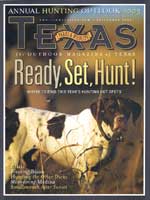
High-Tech Hide-and-Seek
Young and old alike are turning to geocaching, a gadget geek's ticket to fun in the sun.
By Sheryl Smith-Rodgers
On a brisk February morning three years ago, Jana Iannello and her friend Clark Johnson hiked through woods in a San Antonio park. Their mission: find a treasure hidden among the trees using a set of coordinates as their only clues.
Now and then, Iannello, 54, paused to check a small, hand-held device Johnson carried. According to her calculations, they were close to "the spot," but that's all they knew. Quick searches inside old logs and thick brush turned up nothing.
"Finally, I spotted a big rock pile that didn't look natural at all," recalls the retired San Antonio teacher. "I dug around a little bit and found a Tupperware container. I screamed so loud I think you could have heard me all the way to the River Walk. That's when I got hooked. I went out the next weekend and hid a cache myself. I've been geocaching ever since."
Like Iannello, tens of thousands of people worldwide "geocache" (pronounced "geo-cash") for thrills, fun and exercise. Using Global Positioning System (GPS) units, participants download coordinates from the Internet, travel to the designated location, then hunt for the cache, usually an ammo box or plastic container with a surprise inside.
Geocaching.com, the premier caching site, tracks more than 177,718 active caches hidden in 214 countries, including Iraq and Afghanistan.
Will Nienke, president of the Texas Geocaching Association, estimates that more than 1,200 Texans geocache. Many belong to 10 regional caching groups, such as the Greater Abilene Geocachers Association and Southeast Texas Geocachers in Houston.
Finding a cache, as Iannello discovered on her first geocache adventure, is not as easy as it sounds. A "waypoint" (coordinates entered into a GPS unit) only determines an approximate location within 6 to 20 or more feet. It's up to a geocacher's wits and determination to uncover the cache. Sometimes cachers must wait for "muggles" (passersby) to get out of the way.
Generally, caches contain nonsensical trinkets, such as Happy Meal prizes, miniature toy cars or plastic soldiers. Others may contain new CDs, backpacks or even cash. "Virtual" caches lead adventurers to an interesting site, such as a historical marker or a spectacular view.
Geocaching rules are simple. Participants who take a treasure must leave one in its place. They're also asked to sign a logbook in the cache box and pick up any trash they see. Later, most people sign an online log, too.
Rules also prohibit geocachers from placing caches on archeological or historical sites. Geocachers must also obtain permission from private landowners and managers of public lands, including managers at all Texas state parks, before hiding a cache. National Park Service regulations ban caches from federal areas.
"You don't do this for the stuff because a lot of it is junky," says Steve DeFau, 30, of Abilene, who geocaches with his wife, Patricia. "You do it for the experience. Plus we've learned more history than we would from any textbook. There's a historical marker about a mile from our home that we didn't know about until we started geocaching."

